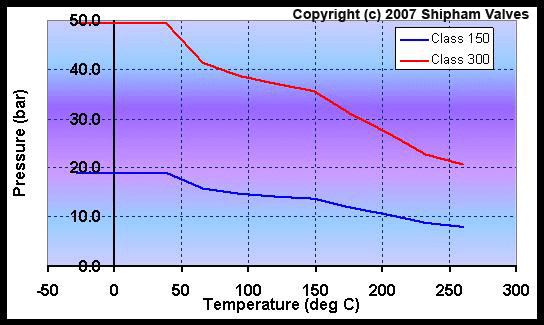Origin |
Standards |
Materials |
Coverage |
Pressures |
USA |
ASME B16.24
EN1759-3:2003 |
B62, B61
C95200 Various Cu alloy |
Class 150,300 FF B16.5 R/F Class 150,300 FF |
Cl150=15.5 bar,300=34.5
Cl150=13.4 bar, 300=35.5 Cl150=15.5 bar,300=34.5 |
Europe |
EN 1092-3:2003 |
Various Cu alloy |
PN6 – PN40 Flat |
PN x = x bar, |
The EN standards have a pressure temperature rating
for NAB (CC333G), but apart from extending the high temperature performance
beyond that of the bronzes, no recognition is made of the yield strength
being over double that of the bronzes.
The American standard, B16.24 does have an aluminium bronze with dimensions to B16.5. This is still weaker than NAB (40%) and stronger than B62 (80%). However the dimensions in this instance require B16.5 dimensions with the raised face, explaining the reduction in the cold working pressure. The clause that allows bronze flange faces to be raised, provided that the extra dimension is added to the thickness appears to be inconsistent with these two ratings.
The European “PN” standards allow both raised and flat face dimensions and a full PN rating irrespective of the material. Due to the weak material and bending moments involved, extreme caution is required for all “bronze” materials with raised face flanges, particularly when bolting-up. Choice of gasket and assembly procedure using controlled bolt loads is critical. The author recommends that bronze flanges with raised faces are avoided wherever possible.
None of the standards recognise the high yield strength of NAB. However, the appendices of B16.34 and B16.5 do give a method for determining the pressure-temperature ratings. If this is used, a cold working pressure of NAB of 19 bar results (see Appendix III). To calculate the pressures at higher temperatures, data on material properties is required. The rating, “SPT01” (Shipham pressure-temperature rating) is presented below in Figure 6.

This rating has been in use at Shipham for many years without any issues, is consistent with the B16.34 rules and enables the full potential of NAB to be safely maximised. It is conceivable that the high temperature ratings could be extended, but NAB is not generally used where this is a requirement and from experience has not found to be necessary.
A similar approach is also required for other materials, particularly titanium. The data is more readily available as titanium is listed within ASME II, which NAB is not.